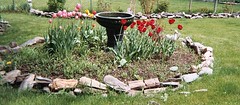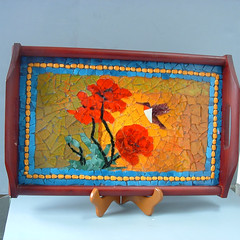 Flathead Lake's
Flathead Lake'sWild Horse Island
I recently had the opportunity to hike the interpretive trail on Wild Horse Island. Accessible only by boat, Wild Horse Island is a primitive 2,000-acre State Park on Flathead Lake. It is the largest island in Flathead Lake and is rich in history. Reportedly, the Salish-Kootenai Indians used the island to pasture their horses and keep them from being stolen by other tribes. Homesteaders tried farming on the island. There are about 35 private lots and cabins along the perimeter of the island, but as the island is now a State park, no more building is allowed.
The island park is noted for its wildlife, which includes up to 250 Rocky Mountain bighorn sheep, 100 mule deer, birds, waterfowl, bald eagles, osprey and falcons, along with wild horses. The island is a favorite of hikers, boaters and swimmers.
Flathead Lake is one of the 300 largest natural lakes in the world and is the largest natural freshwater lake in the western United States. Of those large lakes, Flathead is one of the cleanest. Studies at the Flathead Lake Biological Station show that water quality in Flathead Lake is among the best in the world. Due to its massive volume and normally active winds over the surface, Flathead Lake does not freeze over most winters, although the bays often have winter ice cover.Located in the northwest corner of the state, it is approximately 30 miles long and 16 miles wide, covering 191.5 square miles. Flathead Lake is 30 miles southwest of Glacier National Park and is flanked by two scenic highways, which wind along its curving shoreline.
The lake is bordered on its eastern shore by the Mission Mountains and on the west by the Salish Mountains. The Flathead valley was formed by the glacial damming of the Flathead River and sustains a relatively mild climate for a region located this far north and inland; the Pacific Ocean is almost 400 miles to the west. The mild climate allows for the many cherry orchards that grow on the east shore and produce the famous Flathead Cherries. Vineyards for wine production exist on the west shore. There are also apple, pear and plum orchards around the lake as well as vegetable, hay, honey, nursery tree, Christmas tree, sod/turf and wheat production bordering or near the lake.
Of the 25 fish species most commonly found in the Flathead River-Lake ecosystem, 10 species are native and 15 have been introduced. The native species include redside shiner, peamouth minnow, squawfish minnow, largescale sucker, longnose sucker, sculpin, bull trout, cutthroat trout, pygmy whitefish and mountain whitefish. Lake trout, lake whitefish and yellow perch are the most common nonnatives and have increased in abundance since 1970, whereas native species have declined.
It is also reportedly inhabited by the infamous Flathead Lake Monster.

Wild Horse Island







